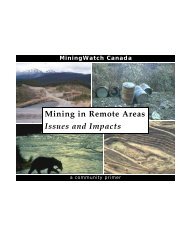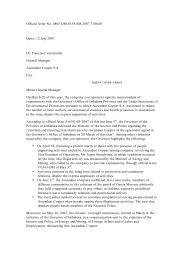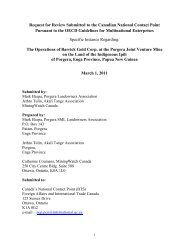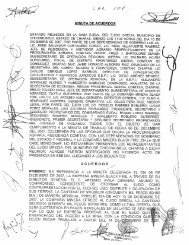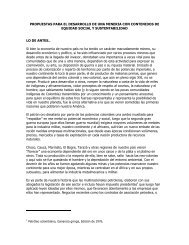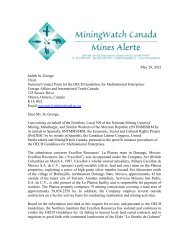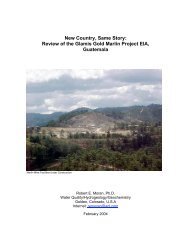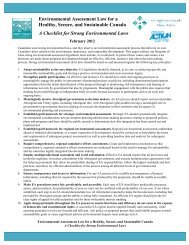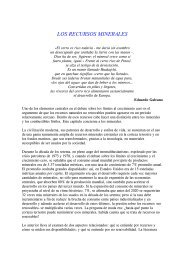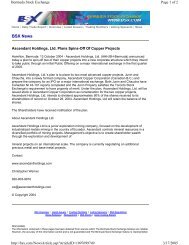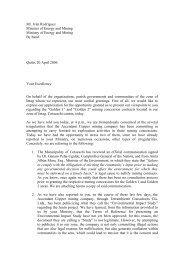Environmental Aspects of Phosphate and Potash Mining
Environmental Aspects of Phosphate and Potash Mining
Environmental Aspects of Phosphate and Potash Mining
- No tags were found...
You also want an ePaper? Increase the reach of your titles
YUMPU automatically turns print PDFs into web optimized ePapers that Google loves.
<strong>Environmental</strong> <strong>Aspects</strong> <strong>of</strong> <strong>Phosphate</strong> <strong>and</strong> <strong>Potash</strong> <strong>Mining</strong>Beneficiation plants frequently implement measuresto contain <strong>and</strong> recover process spillages, in order tominimize environmental effects <strong>and</strong> product loss.Water ConsumptionBeneficiation operations generally consume largequantities <strong>of</strong> fresh water for processes such as washing<strong>and</strong> flotation. The water is usually sourced from nearbysurface <strong>and</strong> ground water supplies. In arid areas,local water supplies may be limited, requiring water tobe piped considerable distances.Water piped in from distant sources may provide asuitable source for other users.Provision <strong>of</strong> Water Resources to Other UsersIn New Mexico, the Mississippi Chemical Corporationpipes water from a distant freshwater aquifer to theirCarlsbad potash operation. Local groundwater in thevicinity <strong>of</strong> the operation is high in total dissolvedsolids <strong>and</strong> not suitable for human or livestock consumption.The freshwater pipeline has provided awater source available for local ranchers, reducingreliance on variable rainfall in this arid area.Electrostatic Separation <strong>and</strong> Pneumatic Flotationfor <strong>Potash</strong> OreThe Kali und Salz GmbH operation in Germany hasdeveloped the ESTA electrostatic separation process<strong>and</strong> the pneumatic flotation cell to improve the recovery<strong>of</strong> potash from complex mineralized ores.Implementation <strong>of</strong> these techniques has also createdadditional environmental benefits through reducedenergy consumption <strong>and</strong> waste water production.The ESTA electrostatic separation process requiresthat complex potassium/magnesium ores are dryground to less than 1 millimetre to separate the differentminerals. The particles are conditioned tocreate differential positive <strong>and</strong> negative chargesbetween them. Separation occurs as the mineral particlesare subject to a 125,000-volt potential dropduring free fall. A multi stage separation processallows the various product <strong>and</strong> waste minerals to beisolated <strong>and</strong> concentrated. <strong>Environmental</strong> <strong>and</strong> economicbenefits arise from the dry separation processthat produces no waste brines <strong>and</strong> the relatively lowenergy requirements.A non-mechanical, pneumatic flotation cell has beendeveloped for the separation <strong>of</strong> kieserite (magnesiumsulphate) from halite. In comparison to conventionalmechanical flotation cells the pneumatic cells consumeless energy <strong>and</strong> recover more kieserite.Water management is an important aspect <strong>of</strong> theoperation <strong>and</strong> is usually integrated with waste disposal.Where possible, recirculation or recovery <strong>of</strong> thewaste process water/brine is effected. In many casesthe process waters/brines are used to transport thewastes as a slurry to the disposal areas. Typically, theyare recovered for reuse, minimizing the need for additionalfresh water input.Where fresh water sources are not available for phosphaterock beneficiation, salt water has been used forprocessing. A clean water wash is required afterwards,to reduce the chloride content <strong>of</strong> the ore concentrate.Utilizing dry beneficiation processes reduces waterconsumption. However, it can create additional dustproblems.Water ContaminationContamination <strong>of</strong> surface <strong>and</strong> ground water mayoccur from the spillage <strong>of</strong> process water, brines, oreconcentrates, wastes or chemical reagents during processing.A variety <strong>of</strong> methods to contain spills areused, including drains, bunds around storage <strong>and</strong> processingtanks <strong>and</strong> dams for major process spills.Pneumatic flotation cell - Kali und Salz GmbH,GermanyThese allow spills to be recovered <strong>and</strong> returned to theprocess or be disposed <strong>of</strong> safely.Air ContaminationDry processing operations may generate significantquantities <strong>of</strong> dust during operations such as crushing,grinding, compaction <strong>and</strong> drying. This can be controlledto some extent through the use <strong>of</strong> emissioncontrol equipment such as baghouses <strong>and</strong> wet scrubbers.



